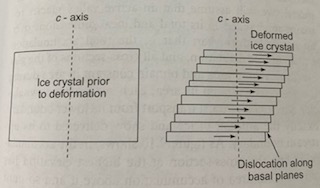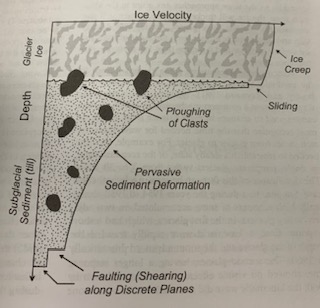Glacier Movement
Glaciers are defined as being bodies of ice that flow downhill, with this movement being facilitated by the relative softness of ice - the primary material making up glaciers - and the staggering weight of the glacier itself. This results in the downslope flow of glaciers through three main processes.
The first is creep, the internal deformation of the glacial ice, which occurs when stress causes strain within the ice.
 |
| Crystal deformation during creep. Source: Ritter, Dale F., et al. Process Geomorphology. Waveland, 2011. |
The second process is basal sliding. This occurs when the weight of the glacier causes pressure melting at its base, creating a film of water that reduces basal friction and allows the glacier to slide.
 |
| Basal sliding. Source: https://quizlet.com/131962130/test |
The final major glacial movement process is subglacial sediment deformation, which occurs when a glacier flows over unconsolidated sediment that mobilizes downslope under the weight of the ice. This deformation occurs whenever the applied shear stress is greater than the shear strength of the sediment, and it is believed that sediment deformation could be associated with up to 90-95% of the motion of some temperate glaciers.
 |
| Graphic relating surface ice velocity to creep, basal sliding, and sediment deformation. Source: Ritter, Dale F., et al. Process Geomorphology. Waveland, 2011. |